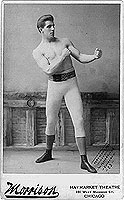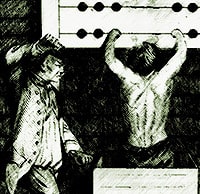It is the common rosy-hued view of the modern historian—in his posthumous collaboration with slave masters past—to depict the two sold souls below as “employees,” having escaped the horrors of poverty and slavery via the good will of their adoptive benefactor, Edward Roe. However, the word servant was the preferred word for human property as established in the King James Bible. Whatever the slipper semantics, John Thorn was property, living the life we moderns associate with slavery, and his nameless fellow captive did not even rank a name. It might prove instructive that the standard 7-year term for an English servant transported, imported, dutied, indented or taken by the scandalous “headright” system to the Plantations of Maryland and Virginia was not adopted until after the experiment of Jamestown demonstrated that less than 5% of servants survived 7 years. Indeed, of the 67 white servants that the 35 English Puritans brought to Plymouth, less than half survived the first winter. By the time young John Thorn had completed his term of hard labor on a diet of corn and water he would have been all but worn out, even if he were not beaten daily, which was the norm for children and servants of the time. If he made it to the end of his term of service, the prospect of being released with nothing but the clothes on his back, no tradesman’s tools and no money, and only a freedom paper [which, if lost, would put him at the mercy of any who wished to enslave him] would have been daunting.
As for the unnamed servant, he was nothing more than an animal to be used until he became useless.
1 boy servant named John Thorn at 5 years to serve - 2000 pounds tobacco [2]
1 East India servant boy - 2500 pounds tobacco [3]
(Talbot County)
-Maryland Prerogative Court (Inventories)
Notes
1. This inventory of a presumably deceased Captain Roe was taken during the height of Bacon’s Rebellion in neighboring Virginia, to which Maryland dispatched a battalion strength force.
2. Note that the dismissive term beloved of modern Americans “indentured” is not noted in this legal document. Indeed, most child servants were not indentured, but kidnapped and many that were indentured were in effect being sold by a widowed parent or orphaned older sibling.
3. Note that the East Indian servant boy did not even have a name and was worth 25% more in tobacco, than John Thorn, who would have been 13 years, probably sold at 10 years. This possibly reflects the fact that child laborers in Maryland and Virginia in the 17th Century rarely lived past age 21 and the boy could be expected to serve effectively until that age. Maryland was so poor during this period that most business was conducted in tobacco, making the acquisition of African slaves difficult, as such merchants who dealt in that race wanted coin for their freight.
Books by James LaFond











It’s interesting how word usage has changed over the centuries. “Servant” comes to us from the Latin “servus” meaning slave. The original Anglo-Saxon word for a slave was “thrall”, from which we get our modern word “enthralled”. The word "slave" comes to us from the word “Slav”, since from the Fifth to the Tenth Centuries a chattel slave in England was likely to be a Slav taken captive by German or Norse raiders. For a long time slaves were the most valuable commodity one could capture in a war. Wars were fought to take slaves in order to get rich AND to keep from being enslaved. Notice the different word usage in the NIV and KLV translations of the Bible.
“For I am a man under authority, having soldiers under me: and I say to this man, Go, and he goeth; and to another, Come, and he cometh; and to my servant, Do this, and he doeth it.” - Matthew 8:9 (KJV)
“For I myself am a man under authority, with soldiers under me. I tell this one, ‘Go,’ and he goes; and that one, ‘Come,’ and he comes. I say to my servant, ‘Do this,’ and he does it.” - Matthew 8:9 (NIV)
"The rich ruleth over the poor, and the borrower is servant to the lender." - Proverbs 22:7 (KJV)
"The rich rule over the poor, and the borrower is slave to the lender." -Proverbs 22:7 (NIV)
The New International Version (NIV) of the Bible is a translation of the Scriptures from the original Hebrew and Greek into modern English, with the last edition having been published in 2011. The King James Version (KJV) was published in 1607 and translated from the Hebrew and Greek into what we refer to today as Elizabethan English, in other words the English language as it was spoken some 400 years ago in the age of Queen Elisabeth I and playwright William Shakespeare. The Old Testament of the Bible was originally written in Hebrew and then later translated into Greek for the Hellenized (Greek speaking) Jews who lived in Alexandria Egypt. The New Testament was originally written in Greek. The Greek word for slave is δοῦλος (doulos – pronounced doo’ los). Incidentally, “robot” is the Czech word for slave. It comes to us from the 1920 play R.U.R. by the Czech writer, Karel Čapek. Anyway as you mentioned James, the white people who were referred to in writing as “servants” in 17th and 18th century America were slaves in our modern understanding of the term. The only distinction being that the white slaves were serving a sentence, rather than being life-time chattel slaves or property. Since the white slaves were rented or leased rather than long term property they were not unexpectedly treated worse than the black slaves. They were “beaten like a rented mule”. So the white slaves frequently did not survive their sentence. Just like galley slaves in this period; a life sentence in the galleys usually only meant a maximum of five years as a practical matter since the galley slaves were invariably worked and starved to death and thrown overboard before five years had passed. Whereas the black slaves were often cared for as a long term asset, like livestock or even a pet.
Thanks so much for this, Jeremy.
I've been nipping at the question on a case by case and have left it dangle.
The quotes from Proverbs 22:7 really nail the subject. Thanks for that/ I'm going to save it.